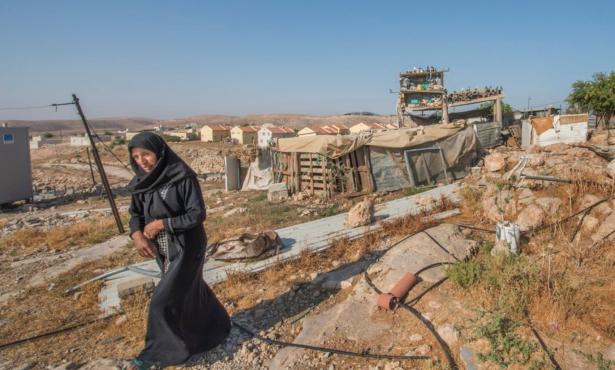On June 26, after fourteen years of avoiding destruction, the Israeli military entered the village of Umm al-Kheir and demolished eleven homes, the village council tent, and the solar electricity room, leaving one-third of the town’s population homeless.
Umm al-Kheir is a Bedouin community of roughly 200 people, all members of the Hathleen tribe, located in the South Hebron Hills in the southern West Bank. As per the Oslo Accords, it is located in Area C, which places it under full Israeli civil and military control. Home demolitions are common for Palestinians in Area C, where Israeli officials deny 95 percent of Palestinian building permit requests, then demolish the homes on the grounds that they were built illegally.
A visit through Umm al-Kheir reveals a variety of tributes to people around the world: a sign thanking a British politician for donating money to build a basketball court, murals painted by an artist and Jewish Voice for Peace (JVP) activist based in Pittsburgh, and pictures in the local community center featuring international activists, to name a few. Perhaps it is due to this support that Umm al-Kheir, where almost every building is under an active demolition order, has dodged destruction for over a decade. But the transfer of the village’s jurisdiction from the Israeli Civil Administration into the hands of far-right Israeli National Security Minister Itamar Ben-Gvir has been catastrophic for the community.
During the Second Intifada in the early 2000s, the nongovernmental organization Ta’ayush began documenting settler violence in Umm al-Kheir and the rest of the South Hebron Hills. Members of the organization have accompanied local Palestinians as they graze sheep and work on agricultural land. While doing so, Ta’ayush records violence and oppression from the Israeli military—including any arrests of Palestinian villagers and restrictions of Palestinian access to their land.
Since Ta’ayush’s arrival in the South Hebron Hills, the community of Umm al-Kheir has received support from international Jewish and non-Jewish activist groups, such as If Not Now, JVP, and the International Solidarity Movement. These groups and others have engaged in volunteer work similar to that of Ta’ayush in the village, and awareness campaigns focused on settler violence and home demolitions in the region.
Eid Hathleen, a photographer and activist from Umm al-Kheir, tells The Progressive that the soldiers seen at the recent demolitions were not from the Civil Administration. Instead, all of the forces at the scene were from the Israeli Border Police, a quasi-militarized branch of the Israeli police that is particularly present in East Jerusalem and Area C, leading many to believe Ben-Gvir ordered these demolitions himself.
Since June 26, Umm al-Kheir—along with the entire South Hebron Hills—has turned into a war zone. Within the last month, residents and activists throughout the region have documented settlers beating two elderly Palestinian residents, Israeli soldiers opening fire on local Palestinians and carrying out home demolitions, and other acts of violence.
In Umm al-Kheir, settlers stormed the village, attacked Palestinian residents and activists with tear gas and wooden sticks, and opened fire on residents, ultimately injuring and hospitalizing four women, a five-year-old girl, and a seventeen-year-old boy. One of the settlers present at the attack was a man named Shimon Atia, who runs a nearby illegal outpost called Shorashim Farm. Settler youth from the outpost cut Umm al-Kheir’s water pipe. The villagers were able to repair the pipe, but the settlers returned and cut it again shortly after.
In the middle of the night on July 24, soldiers entered Umm al-Kheir and dismantled a temporary tent intended for upcoming weddings. Tariq Hathleen, an English teacher and activist, says that the village had permission to build the tent from the Civil Administration. The soldiers refused to identify themselves, and Tariq suspects they were settlers in uniform. Due to the uptick in civilians serving reserve duty in the Israeli military since October 7, it has become common for settlers to carry out violence against Palestinians in military uniform while not acting on any military order.
Perhaps nearby settlers saw a moment of weakness after the June 26 demolitions. Perhaps there was some other impetus for this recent campaign of violence. What is clear, however, is that, like all settler violence, this is not random, but rather a concerted effort to kick the Palestinian people of Umm al-Kheir, and the South Hebron Hills region, off of their own land—forcing multiple communities to flee.
Since October 7, a new precedent has emerged of the U.S. government sanctioning violent settlers, including Issachar Mann who has been seen in Umm al-Kheir grazing his sheep on private Palestinian land. With American ties to the small village already strong, recent events could lead to a strong push to pressure the U.S. government to place sanctions on Atia. As the orchestrator of much of the violence against Umm al-Kheir, he is a prime target for an American government that is beginning to show interest in distancing itself from Ben-Gvir and the Israeli settler movement.
[Sam Stein is a Jewish-American activist based in Jerusalem. For more, follow him on Instagram and Twitter @sam_avraham]


Spread the word